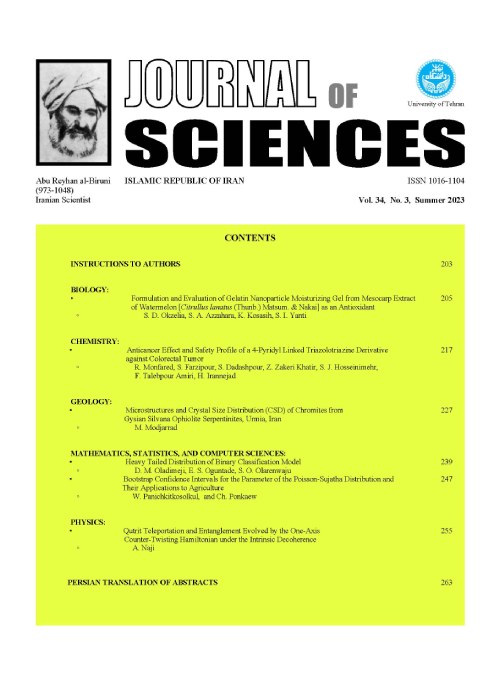فهرست مطالب

Journal of Sciences, Islamic Republic of Iran
Volume:31 Issue: 2, Spring 2020
- تاریخ انتشار: 1399/01/13
- تعداد عناوین: 9
-
-
Pages 105-111
Pseudomonas aeruginosa is a common cause of surgical-site infections and healthcare-associated infections in the bloodstream, and urinary tract. Iron oxide nanoparticles (IONPs) have shown, to possess antibacterial features. The nanoparticles' status as emerging therapeutic elements has motivated investigators to assess the effects of iron nanoparticles on the expression of TEM type beta-lactamase genes in P. aeruginosa. In this descriptive-analytic study, 60 clinical isolates of P. aeruginosa were isolated from burn wounds and respiratory excretions of Pasargad Research Laboratory of Tehran, Iran. All isolates were characterized using differential biochemical tests and confirmed samples as P. aeruginosa. Their genomic DNA was extracted and PCR reaction was performed to screen TEM-gene carrying isolates. Then MIC of IONPs against these strains was determined and finally, Real-time PCR performed to the determination of the expression of the TEM gene. Results showed that 8 isolates (13/33%) had the TEM beta-lactamase gene. The MIC and MBC of IONPs against P. aeruginosa strains were observed at 256 µg/mL or 125 µg/mL, while the MBC was determined at 500 µg/mL. In addition, statistical analysis of Real-time PCR data showed that there is a statistically significant difference between gene expression levels of IONPs treated isolates and non-treated ones. The results showed that TEM gene expression levels in two isolates treated with IONPs were 78% and 75% lower than untreated bacteria (P<0.001; r= 0.958). Our findings confirmed that IONPs are potential antibacterial agents and can be considered as promising treatments for recalcitrant P. aeruginosa infections.
Keywords: P. aeruginosa, TEM beta-lactamase, Iron oxide nanoparticles -
Pages 113-119
Head and neck squamous cell carcinoma (HNSCC) represents a large majority of cancers arising from the head and neck, especially the oral cavity. Despite advances in therapy, the five-year survival rate remains low due to the number of patients presenting advanced stages of the disease. The role of epithelial-mesenchymal transition (EMT) in tumorigenesis in HNSCC remains unexplored. The current study aimed at investigating the mRNA expression of the three major factors in tumor specimens to define their functional and pathological roles in this malignancy. The expression of E-cadherin, vimentin, and tumor necrosis factor (TNF)-α were examined in 31 tumorous and 31 non-tumorous samples obtained from patients with HNSCC. Total RNA was extracted from all tumors for cDNA synthesis and mRNA expression levels of E-cadherin, vimentin, and TNF-α were assessed by real-time PCR. We showed a significant decrease in E-cadherin expression and increase in vimentin and TNF-α expression in tumorous samples in comparison with non-tumorous ones (P ≤0.05). Also, there was a significant correlation between vimentin mRNA expression and poor differentiation of tumor (P ≤0.05).Since many studies investigated EMT markers in head and neck cell lines, the current study on human samples can unveil the role of these markers in HNSCC and their relationship with patients` clinicopathological features. Therefore, it might be possible to prevent it, and a therapeutic strategy could be effective in the future.
Keywords: HNSCC, EMT, metastasis, inflammation, gene expression -
Pages 121-126
Aqueous solutions of mono, di, and triprotic acids were prepared with different molar percentages (say 10%, 20% and 30%). ammonium dihydrogen phosphate is gradually introduced in the aqueous solutions at different concentrations varied from 0.1M to 0.6M at 303K. Densities, viscosities, and velocity of sound of aqueous solutions are measured and they are used to evaluate the other parameters like adiabatic compressibility (β), free length (Lf), internal pressure (πi), apparent molar volume (φV), apparent molar compressibility (φK) and relative Association (RA) of the solution. Experimental results are analyzed based on molecular associations like hydrogen bonding and dipole-dipole interactions between the component molecules, which revealed that the variation of the parameters with the different molar concentrations of both ammonium dihydrogen phosphate and the acids.
Keywords: aqueous solutions, Molecular Association, Hydrogen Bonding, Ultrasonic Study -
Pages 127-135
The pillared-layer metal-organic framework of Ni2(BTEC)(bipy)3.3DMF.2H2O (BTEC = 1,2,4,5-benzenetetracarboxylate; bipy = 4,4́-bipydine; DMF =N,Ń-dimethylformamide) was prepared, characterized and used as a precursor for preparation of NiO nanoparticles. The morphology and structure of NiO nanoparticles were characterized by XRD, SEM, FT-IR and EDX techniques. It was found that the synthesized MOF and NiO nanoparticles catalyze the aromatization of 4-substituted Hantzsch 1,4-dihydropyridines (R= Ph, Me, H) with 100% conversion and 100% selectivity toward the desired products.
Keywords: Pillared-layered NiMOF, NiO nanoparticles, Aromatization -
Pages 137-146
The hybrid density functional theory (B3LYP) and ab initio molecular orbital (HF) based methods and Natural Bond Orbital (NBO) interpretation were used to analyze the conformational behaviors of 2,5,5-trimethyl-1,3,2-dioxaphosphinane 2-selenide (compound 1), 2,5,5-trimethyl-1,3,2-dithiaphosphinane 2-selenide (compound 2) and 2,5,5-trimethyl-1,3,2-diselena phosphinane 2-selenide (compound 3). The results explained that the axial conformations had a preference of compounds 1-3. The relative energies ∆E0 and Gibbs free energy difference values (ΔGeq-ax) between the ax and eq-conformations were calculated and showed the decrease from compound 1 to 3. Stereo electronic effect (SE) for 1 to 3 has been calculated by the NBO analysis. Therefore, in this study, other factors such as stereo electronic effects, electrostatic and steric interactions of compounds 1 to 3 conformational behavior have been evaluated. One examined whether the stereo electronic effect is the only factor affecting the conformational behavior or not? The electronic properties such as the HOMO and LUMO energies were also determined to investigate the reactive sites of the compounds. Structural-relative activities of compounds are also evaluated.
Keywords: NBO, Stereo electronic interaction, Electronic properties, Dioxaphosphinane 2-selenide -
Pages 147-153
A new series of 2-(5-nitro-2-heteroaryl)-1,3,4-thiadiazole derivatives, including nitro furan, nitro thiophene and nitro imidazole, were synthesized and screened in vitro for their inhibitory activity against eight bacterial strains. The results showed that most of the synthesized compounds were active against Gram-positive bacteria, determined by MIC method. Among them, compounds 6a, 6b and 6d exhibited strong anti-bacterial effects against the Gram-positive bacteria. The oxidation of synthesized compounds to sulfinyl and sulfonyl bearing analogues did not improve the activity.
Keywords: 1, 3, 4-Thiadiazole, Antibacterial activity, synthesis -
Pages 155-164
The aim of this study is to analyze the assemblage of trilobites in the Silurian sequences of Iran by exploring stratigraphic section of the Silurian Niur Formation (Asadli section). Based on comprehensive field studies and laboratory investigations three Trilobite genera were identified in the study area including Calymene blumenbachii, Gravicalymene convolva, Dalmanites brevigladiolus and Calymene sp. according to this trilobite assemblage a Rhuddanian to Telychian stages (Llandovery) is suggested for deposition of the study strata. The recognized trilobite fauna will be used as a base for future geological studies on the Silurian strata in Kopeh-Dagh Basin. This is the first report of trilobites from the Silurian (Llandovery) Niur Formation in Asadli section, north- east, Iran.
Keywords: Trilobite, Calymene, Biostratigraphy, Silurian, Iran -
Pages 165-173
Spam is an unwanted email that is harmful to communications around the world. Spam leads to a growing problem in a personal email, so it would be essential to detect it. Machine learning is very useful to solve this problem as it shows good results in order to learn all the requisite patterns for classification due to its adaptive existence. Nonetheless, in spam detection, there are a large number of features to attend as they play an essential role in detection efficiency. In this article, we're working on a feature selection method to e-mail spam. This approach is considered a hybrid of optimization algorithms and classifiers in machine learning. Binary Whale Optimization (BWO) and Binary Grey Wolf Optimization (BGWO) algorithms are used for feature selection and K-Nearest Neighbor (KNN) and Fuzzy K-Nearest Neighbor (FKNN) algorithms are applied as the classifiers in this research. The proposed method is tested on the "SPAMBASE" datasets from UCI Machine learning Repesotries and the experimental results revealed the highest accuracy of 97.61% on this dataset. The obtained results indicateed that the proposed method is suitable and capable to provide excellent performance in comparison with other methods.
Keywords: Spam Mails, Whale Optimization Algorithm, Grey Wolf Optimization Algorithm, fuzzy K-Nearest Neighbor algorithm (FKNN), Feature Selection -
Pages 175-183
Penalized spline criteria involve the function of goodness of fit and penalty, which in the penalty function contains smoothing parameters. It serves to control the smoothness of the curve that works simultaneously with point knots and spline degree. The regression function with two predictors in the non-parametric model will have two different non-parametric regression functions. Therefore, we propose the use of two smoothing parameters in the bi-variate predictor non-parametric regression model. We demonstrated its ability through longitudinal data simulation studies with a comparison of one smoothing parameter. It was done on several numbers of subjects with repeated measurements. The generalized cross validation value which is a measure of the model's ability is poured through the box plot. The results show that the use of two smoothing parameters is more optimal than one smoothing parameter. It was seen through a smaller generalized cross validation value on the use of two smoothing parameters. Application of blood sugar level data for patients with two smoothing parameters produced a penalized spline bi-variate predictor regression model with several segments of change patterns. There are five patterns at the time of treatment and blood pressure with the number of smoothing parameters is two, namely 0.39 and 0.73.
Keywords: Bi-variate, Longitudinal data, Penalized Spline, Smoothing Parameter


